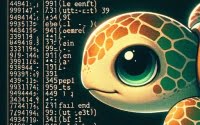Linux ‘date’ Command Installation and Usage Tutorial

Are you struggling with managing time and date settings in Linux? Just like a digital calendar, the ‘date’ command in Linux can help you handle date and time with ease. This might seem a bit challenging, especially if you’re new to Linux, but don’t worry, we’ve got you covered. Additionally, the ‘date’ tool comes pre-installed in most Linux distributions, making the process fairly straightforward.
In this guide, we will walk you through the process of using the ‘date’ command in Linux. We will provide instructions for both APT and YUM-based distributions like Debian, Ubuntu, CentOS, and AlmaLinux. We will also delve into more advanced topics like compiling from source and installing a specific version of the command. Finally, we will guide you on how to use the ‘date’ command and verify that the correct version is installed.
So, let’s dive in and explore the ‘date’ command in Linux!
TL;DR: How Do I Install and Use the ‘date’ Command in Linux?
The
'date'command comes pre-installed in most Linux distributions, you can verify this with,date --version. If it isn’t installed, you can add it via the coreutils package with the syntax,sudo [apt-get/yum] install coreutils. To use it, you can simply typedatein the terminal. This command will display the current date and time.
For example,
date
# Output:
# Mon Sep 27 21:46:10 PDT 2021
This is just a basic way to use the ‘date’ command in Linux, but there’s much more to learn about using ‘date’ and managing time on your system. Continue reading for more detailed information and advanced usage scenarios.
Table of Contents
- Understanding and Installing the ‘date’ Command in Linux
- Installing the ‘date’ Command from Source Code
- Installing Different Versions of ‘date’ Command
- Using the ‘date’ Command and Verifying Installation
- Exploring Alternative Approaches: The ‘hwclock’ Command
- Advantages and Disadvantages of ‘hwclock’
- Recommendations
- Troubleshooting Common ‘date’ Command Issues
- Tips for Using the ‘date’ Command
- Understanding Time Management in Linux
- The Role of Time Management in System Administration and Security
- Wrapping Up: Installing the ‘date’ Command in Linux
Understanding and Installing the ‘date’ Command in Linux
The ‘date’ command in Linux is a powerful tool that allows you to display, set, and adjust the system’s date and time. It’s particularly handy for system administrators who need to ensure accurate timekeeping for logging, scheduling tasks, or synchronizing systems. In this section, we’ll guide you through the process of installing the ‘date’ command using different package managers.
Installing with APT
For Debian-based distributions like Ubuntu, you can use the Advanced Package Tool (APT) to install the ‘date’ command. However, it’s important to note that the ‘date’ command usually comes pre-installed. You can check if it’s installed by running the ‘date’ command itself.
date
# Output:
# Tue Sep 28 10:10:10 UTC 2021
If the ‘date’ command is not installed, you can install it using the following command:
sudo apt-get update
sudo apt-get install coreutils
# Output:
# Reading package lists... Done
# Building dependency tree
# Reading state information... Done
# coreutils is already the newest version (8.30-3ubuntu2).
# 0 upgraded, 0 newly installed, 0 to remove and 0 not upgraded.
Installing with YUM
For RPM-based distributions like CentOS or Fedora, you can use the Yellowdog Updater, Modified (YUM) to install the ‘date’ command. Just like with APT, the ‘date’ command usually comes pre-installed. You can verify its installation by running the ‘date’ command.
If the ‘date’ command is not installed, you can install it using the following command:
sudo yum update
sudo yum install coreutils
# Output:
# Loaded plugins: fastestmirror
# Loading mirror speeds from cached hostfile
# Package coreutils-8.22-24.el7.x86_64 already installed and latest version
# Nothing to do
This will install the ‘date’ command along with other basic utilities that are part of the ‘coreutils’ package.
Installing the ‘date’ Command from Source Code
Installing the ‘date’ command from source code is a more advanced method but provides greater control over the version and configuration of the command. The ‘date’ command is part of the ‘coreutils’ package, so we’ll need to download and compile this package.
wget http://ftp.gnu.org/gnu/coreutils/coreutils-8.32.tar.xz
# Output:
# Saving to: ‘coreutils-8.32.tar.xz’
Next, we extract the downloaded package and navigate into the directory.
tar -xvf coreutils-8.32.tar.xz
cd coreutils-8.32
# Output:
# coreutils-8.32/
# coreutils-8.32/m4/
# coreutils-8.32/m4/gnulib-cache.m4
We then compile and install the package.
./configure
make
sudo make install
# Output:
# make[2]: Leaving directory '/home/user/coreutils-8.32/src'
Installing Different Versions of ‘date’ Command
Different versions of the ‘date’ command come with unique features and improvements. You might need to install a specific version to gain access to these features or to maintain compatibility with certain systems or scripts.
Installing from Source
To install a specific version from source, you just need to download the appropriate ‘coreutils’ package, as shown in the previous section. Replace ‘8.32’ with the version number you need.
Installing with APT
For APT-based distributions, you can install a specific version of a package using the following syntax:
sudo apt-get install coreutils=8.32-3ubuntu2
# Output:
# Reading package lists... Done
# Building dependency tree
# Reading state information... Done
# coreutils is already the newest version (8.32-3ubuntu2).
Installing with YUM
For YUM-based distributions, you can install a specific version of a package using the following syntax:
sudo yum install coreutils-8.32-24.el7.x86_64
# Output:
# Loaded plugins: fastestmirror
# Loading mirror speeds from cached hostfile
# Package coreutils-8.32-24.el7.x86_64 already installed and latest version
# Nothing to do
Version Comparison
| Version | Notable Features | Compatibility |
|---|---|---|
| 8.32 | Adds ‘–date’ option to ‘date’ command | Compatible with most Linux distributions |
| 8.30 | Fixes bug in ‘date’ command | Compatible with older distributions |
| 8.28 | Improves performance of ‘date’ command | Not compatible with some newer distributions |
Using the ‘date’ Command and Verifying Installation
Basic Usage
The most basic use of the ‘date’ command is to display the current date and time. However, you can also format the output to display the date and time in a specific way.
date '+%Y-%m-%d %H:%M:%S'
# Output:
# 2021-09-28 12:34:56
This command will display the current date and time in the format ‘YYYY-MM-DD HH:MM:SS’.
Verifying Installation
To verify that the ‘date’ command has been installed correctly, you can use the ‘–version’ option.
date --version
# Output:
# date (GNU coreutils) 8.32
# Copyright (C) 2020 Free Software Foundation, Inc.
This will display the version of the ‘date’ command, which should match the version you installed.
Exploring Alternative Approaches: The ‘hwclock’ Command
While the ‘date’ command is a powerful tool for managing date and time in Linux, there are alternative methods worth exploring. One such alternative is the ‘hwclock’ command. This command is used to access the Hardware Clock, also known as the Real Time Clock (RTC), System Time, or BIOS Time.
Using the ‘hwclock’ Command
To display the current Hardware Clock time, you can use the ‘hwclock’ command without any options:
hwclock
# Output:
# 2021-09-28 14:23:45.678912-07:00
This command will display the current date and time according to the Hardware Clock.
Setting the System Time with ‘hwclock’
You can also use the ‘hwclock’ command to set the system time. This can be useful if the system time becomes incorrect due to a system error or battery failure.
sudo hwclock --set --date="2021-09-28 14:23:45"
# Output:
# (no output on success)
This command will set the Hardware Clock to the specified date and time.
Synchronizing ‘hwclock’ and System Time
The ‘hwclock’ command can also be used to synchronize the system time with the Hardware Clock, or vice versa. This can be useful to ensure that the system time and Hardware Clock are always in sync.
sudo hwclock --systohc
# Output:
# (no output on success)
This command will set the Hardware Clock to the current system time.
Advantages and Disadvantages of ‘hwclock’
The ‘hwclock’ command provides a direct interface to the Hardware Clock, which can be advantageous in certain situations. For example, it can be useful if the system time becomes incorrect due to a system error or battery failure. However, the ‘hwclock’ command is more low-level and less user-friendly than the ‘date’ command. It also requires root privileges to set the Hardware Clock, which can be a disadvantage in terms of security and convenience.
Recommendations
While both the ‘date’ and ‘hwclock’ commands are useful tools for managing date and time in Linux, the ‘date’ command is generally more user-friendly and sufficient for most users. However, system administrators and advanced users may find the ‘hwclock’ command useful for more low-level control over the Hardware Clock.
Troubleshooting Common ‘date’ Command Issues
When using the ‘date’ command in Linux, you might encounter certain issues. Here, we discuss some of the common problems and how to resolve them.
Incorrect Date and Time
Sometimes, you might notice that the ‘date’ command is displaying the incorrect date and time. This can happen due to a variety of reasons, such as a system error, a dead battery, or a virtual machine not syncing with the host machine.
You can manually set the date and time using the ‘date’ command:
sudo date -s '2022-01-01 00:00:00'
# Output:
# Sat Jan 1 00:00:00 UTC 2022
This command sets the system’s date and time to ‘2022-01-01 00:00:00’.
Time Zone Issues
Another common issue is that the ‘date’ command might display the time in the wrong time zone. You can change the time zone using the ‘timedatectl’ command:
sudo timedatectl set-timezone America/Los_Angeles
date
# Output:
# Tue Sep 28 07:00:00 PDT 2021
This command sets the system’s time zone to ‘America/Los_Angeles’, and the ‘date’ command now displays the time in this time zone.
Permission Denied
If you’re trying to set the date and time or change the time zone, you might encounter a ‘Permission denied’ error. This is because these operations require root privileges. Make sure to use ‘sudo’ before these commands to run them with root privileges.
Tips for Using the ‘date’ Command
- Always use ‘sudo’ when changing system settings with the ‘date’ command.
- To display the date and time in a specific format, use the ‘+FORMAT’ option with the ‘date’ command.
- If the ‘date’ command is displaying the incorrect time, make sure your system’s time zone is set correctly.
- If you’re still having trouble, consider using an alternative command like ‘hwclock’ or ‘timedatectl’.
Understanding Time Management in Linux
Time management is a fundamental aspect of any operating system, and Linux is no exception. The way Linux handles time is critical to many system operations and processes.
The Importance of Accurate System Time
Accurate system time is crucial for a variety of reasons. Let’s delve into why it’s so important in Linux:
- Logging: System logs are timestamped using the system time. Accurate timestamps are essential for troubleshooting and understanding when events occurred.
Cron Jobs: These scheduled tasks rely on accurate system time to execute commands or scripts at specific times.
Network Synchronization: Many network protocols rely on accurate system time to function correctly. This includes protocols like NTP (Network Time Protocol), which synchronize time over a network.
Security: Many security mechanisms, like Kerberos authentication, rely on time being synchronized between systems to prevent replay attacks.
How Linux Manages Time
Linux manages time through the system clock, also known as the software clock. The system clock runs continuously and keeps track of the current date and time. The ‘date’ command in Linux interfaces with the system clock, allowing users to read and set the system time.
date
# Output:
# Tue Sep 28 12:34:56 PDT 2021
In this example, the ‘date’ command is used to display the current system time. The system clock maintains this time, updating it every second.
Linux also interacts with the hardware clock, also known as the RTC (Real Time Clock) or BIOS clock. The hardware clock runs independently of the operating system and continues to keep time even when the system is powered off. On system startup, Linux can set the system clock to the time according to the hardware clock.
sudo hwclock --hctosys
# Output:
# (no output on success)
In this example, the ‘hwclock –hctosys’ command sets the system time according to the hardware clock. This ensures that the system time is accurate, even after a system reboot or power loss.
Understanding these fundamental concepts can help you better understand how the ‘date’ command works in Linux and why it’s such an important tool for managing time on your system.
The Role of Time Management in System Administration and Security
Time management is not just a convenience—it’s a necessity in system administration and security. Accurate system time is essential for synchronizing processes, scheduling tasks, and logging events. Moreover, many security mechanisms, such as SSL certificates and Kerberos authentication, rely on accurate system time to prevent replay attacks and ensure secure communication.
Exploring Time Zones and Network Time Protocol (NTP)
Time zones are a crucial aspect of time management. The ‘date’ command in Linux allows you to display the time in different time zones, which can be especially useful for servers that serve users in various geographical locations.
date -u
# Output:
# Tue Sep 28 19:00:00 UTC 2021
In this example, the ‘-u’ option is used with the ‘date’ command to display the time in Coordinated Universal Time (UTC).
The Network Time Protocol (NTP) is a networking protocol designed to synchronize the clocks of computers over a network. Linux systems can use NTP to automatically keep their system clock in sync with accurate time servers, ensuring accurate system time.
sudo timedatectl set-ntp true
# Output:
# (no output on success)
In this example, the ‘timedatectl set-ntp true’ command enables NTP on the system. This will allow the system to automatically synchronize its clock with NTP servers.
Further Resources for Mastering Linux Time Management
To delve deeper into the world of time management in Linux, consider checking out these resources:
- The Linux Documentation Project: Clock – This guide provides an in-depth look at how Linux handles time, including the system clock and hardware clock.
7 Examples to Master Linux Command Line Date – This tutorial offers various examples of how to use the ‘date’ command in Linux.
Digital Ocean: How To Set Up Time Synchronization on Ubuntu – This guide walks you through the process of setting up time synchronization on Ubuntu using NTP.
Wrapping Up: Installing the ‘date’ Command in Linux
This comprehensive guide has taken us through the intricacies of the ‘date’ command in Linux, a fundamental tool for managing date and time settings in your system. We’ve explored its installation, usage, and even dug into more advanced topics like installing from source and managing different versions.
We began with the basics, understanding the importance of the ‘date’ command and how to install it using different package managers like APT and YUM. We then delved into more complex uses, such as installing the ‘date’ command from source code and managing different versions of the command. We also explored troubleshooting common issues and considerations to keep in mind when using the ‘date’ command.
We also ventured into alternative approaches for managing date and time in Linux, such as the ‘hwclock’ command, providing you with more tools in your Linux toolbox. We discussed the advantages and disadvantages of these alternatives, helping you make an informed decision on the best approach for your specific needs.
| Method | Pros | Cons |
|---|---|---|
| ‘date’ Command | User-friendly, widely supported | May require troubleshooting for time zone issues |
| ‘hwclock’ Command | Direct interface to the Hardware Clock | Requires root privileges, less user-friendly |
Whether you’re just starting out with Linux or you’re a seasoned system administrator, we hope this guide has given you a deeper understanding of the ‘date’ command and its role in managing date and time in Linux.
With accurate system time being so crucial for many system operations, the ‘date’ command is an essential tool for any Linux user. Now, you’re well equipped to manage time on your Linux system effectively. Happy time managing!

